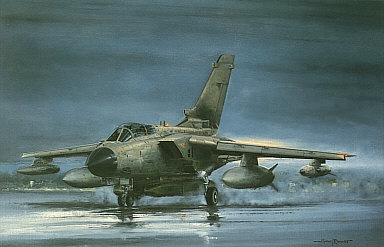In the Air Tonight
During the opening nights of Operation Desert Storm, hundreds of RAF, US and Coalition aircraft unleashed a tidal wave of low-level bombing attacks on airfield targets in Iraq and in occupied Kuwait. Spearheading the RAF attack were Tornado GR.l units based at Tabuk and Dhahran in Saudi Arabia and Muharraq, Bahrain. These early missions, flown at low-altitude, often under cover of darkness, were strictly for the brave. Approaching their targets over featureless desert, the aircrews were faced with ferocious barrages of AAA gunfire and missiles defending the airfields. It took a special kind of determination to press home attacks in the face of the full fury of Iraq's air defences, flying straight and level through curtains of tracer fire to deliver JP 233 weapons.
Afterwards, some of the pilots were icily matter-of-fact about these missions: "You could see the AAA from over twenty miles away, but from five miles out at 200 feet you could just steer a path through the lines of tracer to the target. It was a bit scary, but we were more concerned about being forced off track and laying down our weapons a hundred yards right or left of the intended impact path, than we were about bullets going past the window." Others were more sombre about their experiences, perhaps realising that running a gauntlet of enemy fire and surviving unscathed owed more than a little to luck and the Iraqi gunners' tactics of hosing the sky with unaimed fire.
The television images of the Gulf War air campaign as a series of precision attacks with laser-guided bombs, dropped from the relative safety of medium altitude, takes no account of the fearsome price that was paid in delivering these early low-level attacks. Aircraft were lost; friends were killed or taken prisoner, but the missions continued for five nights until it became clear that the price was too high, and Tornados abandoned low-altitude attacks.
IN THE AIR TONIGHT, the fifth print in Michael Rondot's Gulf War series of paintings, portrays a Tornado GR.I with JP 233 airfield denial weapons taking off at the start of a night low-level mission to attack an airfield target deep within Iraq. The bad weather and dark, overcast evening sky of the first days of the war add power and atmosphere to the dramatic scene as the Tornado accelerates along the runway with afterburners blazing. As a Jaguar pilot working alongside the Tornado crews at Bahrain, Michael Rondot witnessed many scenes like this, and his painting pays tribute to those who flew the Tornado, some of whom, tragically, did not survive the war.
Each print is artist-signed, dated and numbered, and is countersigned by 19 RAF Tornado aircrew from Operation Desert Storm, including holders of the Distinguished Service Order and Distinguished Flying Cross awards for gallantry. A numbered and signed certificate of authentication, with details of the edition and signatories, accompanies every print. Priority will be given to collectors of other prints in the series who wish to obtain matching numbers, and a limited number of remarqued copies with an original pencil drawing on the print border are available at extra cost.
Limited Edition
- 500 prints, signed and numbered by the Artist
- 50 Artist's Proofs





